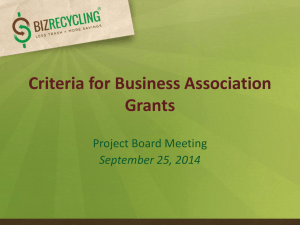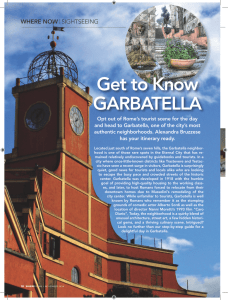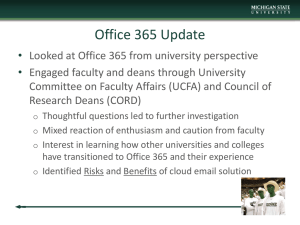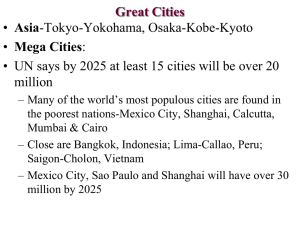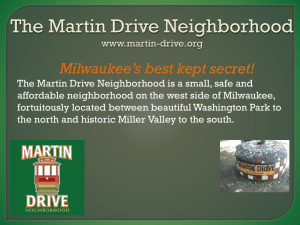MichiganStateUniversity-scanlon
advertisement
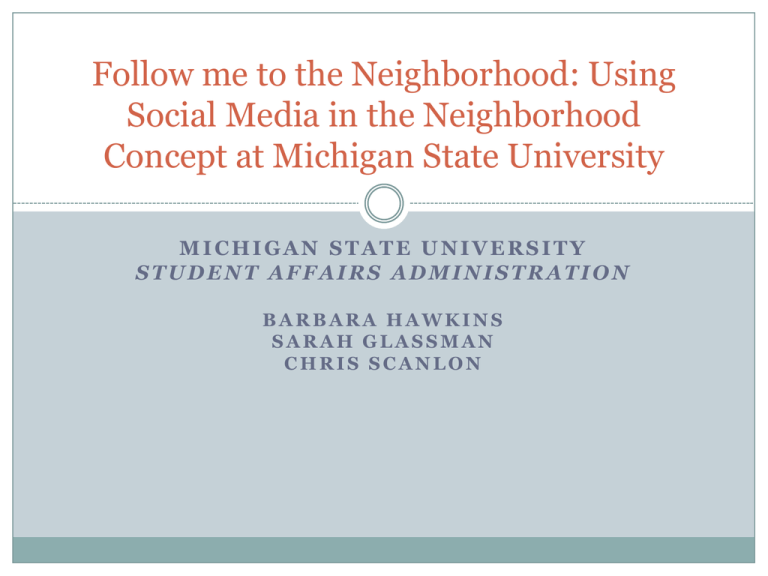
Follow me to the Neighborhood: Using Social Media in the Neighborhood Concept at Michigan State University MICHIGAN STATE UNIVERSITY STUDENT AFFAIRS ADMINISTRATION BARBARA HAWKINS SARAH GLASSMAN CHRIS SCANLON Roadmap Introduction to Michigan State University and the Neighborhood Concept Current social media ventures Recommendations and considerations for continued social media engagement Michigan State University Demographics 36,058 undergraduates ~14,000 residential capacity Suburban campus (5,200 acres) Research I NCAA Division I Public, Land Grant 11 Student Affairs and Services Departments Academic, developmental, identity-based services The Neighborhood Concept Division of Student Affairs and Services (with campus collaboration) 2010-2011 Pilot Implantation in East Campus Small campus feel to a large campus - offering a central engagement center in each neighborhood The Neighborhood Concept Academic and social integration into living learning hallsincluding in-neighborhood advising, resume workshops, health services Tied to major institutional endeavors, including the MSU mission, core values, Boldness by Design, Shaping the Future Both developmental and practical outcomes (helping students develop, staying on campus, retention) Neighborhood Concept and Social Media East Neighborhood Engagement Center Facebook Fan Page (86 followers) Integration of YouTube videos from MSU partner offices SpartanConnect (Intranet social networking forum) neighborhoods.msu.edu (pictures, updates on construction, learning outcomes) High collaboration with Neighborhood constituents (Residential and Hospitality Services, Health Services, various student affairs departments) Recommendations and considerations for continued social media engagement Create a Social Media Virtual Vision Statement Define consistent standards for social networking Vision statement creates and outline of purpose, culture, and goals for the neighborhood social media campaign Align with themes in MSU initiatives and strategic plan Innovation, enhancing student engagement, advancing research, connecting learning in areas outside the class Vision should include details for how social media promotes learning outcomes, advances the University, and enhances the lived experiences in the neighborhoods Reaching out to different demographics, millennial learning styles, engaging in an online and offline community (CAS, 2009; Lipton, 1996; Ellison, Steinfield, Lampe, 2007; Reisser & Roper, 1991) What we know about MSU Students and Social Media MSU students report higher levels of interaction through social media between students who they have met offline, the importance of building students’ social capital, and learning about the people in their residence hall, and learning more about the offline community they are a part of MSU students report lower levels of meeting new people or starting new relationships through social media (Ellison, N B., Steinfield, C, Lampe, C, 2007) Training for Consistent Implementation Social media experts (faculty) at MSU will train student affairs professionals on social media, social media marketing, and how to effectively use social media within each unique neighborhood. Student affairs professionals will advise and train the Social Media Student Committee (SMSC). SMSC will be in charge of all social media accounts for their specific neighborhood Student affairs professionals and SMSC Training Topics: Neighborhood Environment Unique characteristics of their specific neighborhood Population demographics of specific neighborhood Interaction and developing relationships with offices in neighborhoods Training for Consistent Implementation Social Media Marketing Making the most out of neighborhood social media accounts (incentives, advertising, branding) Best way to reach students (what is being used, learning style inventory) Reaching students who do not have social media accounts Keeping up with latest social media trends How to navigate and understand the most recent research Diversity How does diversity play into social media accounts for neighborhood? Diversity activities through social media lens Larger MSU Community/Greater Lansing Community Specific neighborhood and larger campus Incorporation of neighborhood into larger MSU campus and Lansing community Networking with local businesses Providing special deals to students living in neighborhood SMSC will increase faculty/student affairs professional/student interaction Training will continue for student affairs professionals and SMSC throughout the semester/year (Astin, 1999; Schlossberg, 1989) Understanding Social Ecology We all exist within and are shaped by our contexts Individual, relationship, community and society In order to reach individuals and create sustained behavior change, they must be approached at every level of their ecology Social marketing campaigns must be crafted and placed in ways which consider the specific contexts influencing target audiences at each level (Bronfenbrenner, 1979) New Way of Doing an Old Thing Social media were designed to fill an intrinsic human need to connect and converse Effective social media creates, facilitates and maximizes human conversation around meaningful messages and converts the audience into energetic, authentic broadcasters Social Media is used by diverse audiences – regardless of age, ethnicity, gender, or socioeconomic status – it is increasingly widespread and deeply ingrained As there are many observable correlations between online and offline personas – the opt-in, highly personal nature of social media requires dissolving the lines between one’s personal and digital lives – the extension of a social ecological approach into this new space is a natural and useful one. (Universal McCann, 2008; Vazire & Gosling, 2004) Levels of Social Media Ecology Individual, Relationship, Community, Society (Koch, Souder, & Banyan Communications, 2009) Applying Social Media within Social Ecology The current landscape of social media behaviors can be mapped to the four levels of social ecology and provide a framework for effective, measurable communication strategies. Facilitating and maximizing communication across all levels of the social ecological model is necessary to affect students Facilitate conversation Finally, many social media strategies fall victim to old habits and fundamental misunderstandings about the nature of Social Media and how messages travel through it. across all levels of the social ecological model to maximize the scope and potential of those conversations. (Bronfenbrenner, 1979; Gregson, 2001) Student Investment and Involvement MSU students will have the opportunity to become a part in creating the social media environment in their neighborhood SMSC will be composed of students who apply and are accepted to the committee. SMSC will consist of MSU students who: Have a desire to learn more about social marketing Want to use their unique skills to enhance the social media experience in their neighborhood Would benefit from practical experience in the field of their choices Students of all majors encouraged to apply and serve on committee Student affairs professionals from various offices will take turns advising the SMSC Student Investment and Involvement Student’s Major SMSC Task Marketing Marketing of all social media accounts Fine Arts All photography for social media accounts Statistics Assessment for social media accounts Graphic Design Layout and design Communications Relationship building with campus contacts Assessment Strategies Assessment as a practice to grown, learn from, and improve upon practices Different methods for different stages Benchmark before changes, during programs and interventions, post-tests Tracking hits/followers, immediate program evaluation, learning outcomes assessment Astin’s (1991) Inputs-Environment-Outputs Model Within-institution test for campus culture, understanding how students relationship with social networking has changed Collaboration within the division and faculty Residence Life, Communication Arts and Sciences, and more (Astin, 1991; Bliming & Whitt, 1991) References Astin, A. W. (1991). Assessment for excellence. New York: Macmillan. Astin, A. A. (1999). Student involvement: A developmental theory for higher education. Journal of College Student Personnel, 25, pp. 297-308. Bliming, G., & Whitt, E. (1999). Using principles to improve practice. In Bliming, G., & Whitt, E. (Eds.). Good practice in student affairs (pp. 179-204). Washington, DC: Authors. Bronfenbrenner, U. (1979). The ecology of human development. Cambridge,MA: Harvard University Press. Council for the Advancement of Standards. (2009). The book of professional standards for higher education 2009. Washington, DC: Council for the Advancement of Standards in Higher Education. Ellison, Nicole B., Steinfield, Charles, Lampe, Cliff. (2007). The benefits of facebook “friends”: Social capital and college students use of online social network sites. Journal of Computer-Mediated Communication, 12, 1143-1168. Gregson, J. (2001). System, environmental, and policy changes: Using thesocial-ecological model as a framework for evaluating nutrition education and social marketing programs with low-income audiences.Journal of Nutrition Education, 33(1), 4-15. Koch, C., Souder, K, & Banyan Communications. (2009). Social media inthe social ecology: A conceptual framework for behavior change online [PowerPoint slides]. Retrieved fromhttp://www.slideshare.net/BanyanCom/social-media-in-the-social-ecology Lipton, Mark. (1996). Demystifying the development of an organizational vision. Sloan Management Review, 37, 83-92 Oetzel, J. G., Ting-Toomey, S., Rinderle, S. (2006). Conflict communication in contexts: A social ecological perspective. In J.G. Oetzel & S. Ting-Toomey (Eds.), The SAGE handbook of conflict communication. Thousand Oaks, CA: Sage. Reisser, L., & Roper, L. D. (1999). Using resources to achieve institutional missions and goals. In Bliming, G., & Whitt, E. (Eds.). Good practice in student affairs (pp. 113-132). Washington, DC: Authors. Schlossberg, N. K. (1989). Marginality and mattering: Key issues in building community. New Directions for Student Services, 48, pp. 5-15. Schroeder, C. C. (1999). Forging educational partnerships that advance student learning. In Bliming, G., & Whitt, E. (Eds.). Good practice in student affairs (pp. 133-156). Washington, DC: Authors. Universal McCann Comparative Study on Social Media Trends,April 2008 Vazire, S., & Gosling, S. D. (2004). e-Perceptions: Personality impressions based on personal websites. Journal of Personality and Social Psychology, 87(1), 123132.


